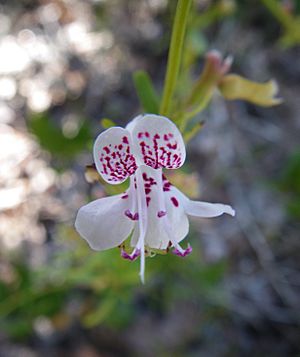Scrub mint facts for kids
Quick facts for kids Scrub mint |
|
|---|---|
 |
|
| Conservation status | |
| Scientific classification | |
| Genus: |
Dicerandra
|
| Species: |
frutescens
|
The Dicerandra frutescens, also known as scrub mint or scrub balm, is a very rare flowering plant. It belongs to the mint family. You can only find this special plant in one place: Highlands County, Florida. It grows on a unique area called the Lake Wales Ridge. Sadly, its home is shrinking fast as land is used for houses and farms. Because it is so rare, the United States government officially listed it as an endangered species in 1985. This means it is protected by law.
Contents
Meet the Scrub Mint!
The scrub mint is a small shrub that usually grows about half a meter (about 20 inches) tall. It has a deep taproot that helps it get water from deep underground. The plant feels a bit sticky and smells very strong, like mint! This strong smell comes from tiny oil glands on its leaves.
What Does it Look Like?
Its leaves are shaped like long ovals and are about 2 centimeters (less than an inch) long. They grow in pairs, one across from the other, along the stem. You can even see the tiny oil glands on the leaves if you look closely.
The scrub mint's flowers are also special. They grow in pairs and are about 1.5 centimeters (about half an inch) long. Each flower has a tube-like shape at the bottom and a mouth with different parts, like lips. The petals are usually white or light pink. They often have darker pink spots on the "lips" of the flower. Long parts called stamens stick out from the flower. These stamens have small, horned tips. The scrub mint blooms, or flowers, from August through October. A special type of bee-fly called Exprosopa fasciata helps to pollinate these flowers.
Where Does it Live?
This plant lives in a special kind of place called Florida scrub habitat. This habitat is found on the Lake Wales Ridge, which is known for its unique plants. Sadly, a lot of this natural home has been destroyed or changed. By 1981, about 74% of this habitat was gone. This loss continues even today.
There are only about fourteen groups of these plants left. Nine of these groups are on private land. This means their future is uncertain, and some might have already been destroyed. The scrub habitat where the plant grows has yellow sand. It is often covered by sand pine trees. Sometimes, it has a mix of oak trees (Quercus species) and scrub hickory trees (Carya floridana).
Why is it in Danger?
The scrub mint's home needs regular wildfires to stay healthy. Fires help to clear out big, woody plants. This creates open spaces that smaller plants, like the scrub mint, need to grow. When people stop fires from happening (this is called Fire suppression), it harms these special plants.
Who Eats the Scrub Mint?
Luckily, not many things harm the scrub mint. It doesn't get many diseases. Most insects also avoid eating it because of its strong, minty oils. However, one type of moth caterpillar, the larva of Pyrausta panopealis, actually eats this plant! The moth larva is not bothered by the strong oils. In fact, it might even use the oils to protect itself. It can vomit the irritating oil onto itself to keep other insects away.


